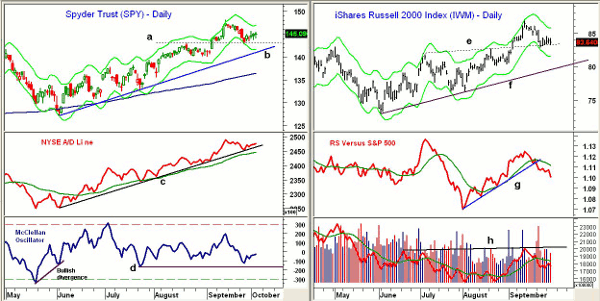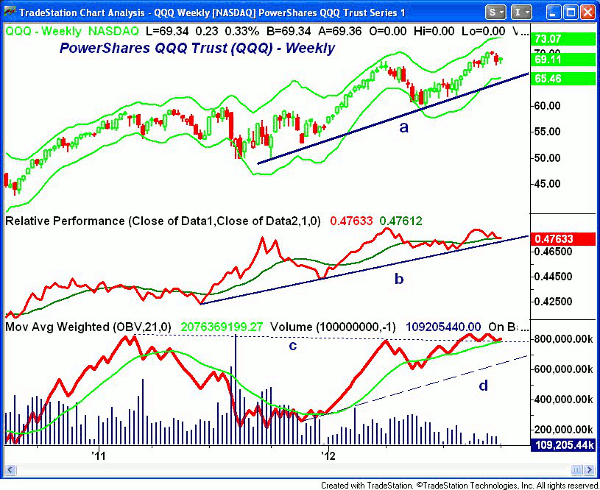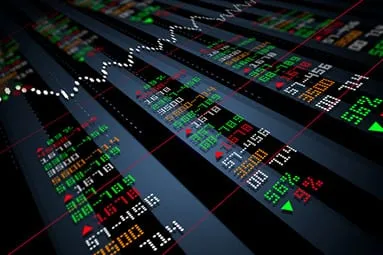With one more day before the widely anticipated September jobs report, stock market bulls and bears are trying to get positioned for the next major move. Will the stock market resume its uptrend or correct further? Moneyshow’s Tom Aspray takes a look.
The stock market had another mixed close Wednesday, as the number of advancing and declining stocks were even. While the Dow Industrials were up just 0.09%, the Nasdaq-100 gained 0.7%. Right in the middle was the S&P 500, which finished 0.36% higher.
The biggest gain came for the badly beaten-down Dow Jones Transportation Average, which was up 1%. It was led by a 4% gain in the airline stocks. This sector was helped by sharply lower crude oil prices.
As for the overall market, the weakness in crude price may be a cause for concern. Oil often leads stock prices, but they have been diverging recently.
The correction from the September 14 highs has now lasted 13 days, and has some similarities to the decline from the August highs. From the August 21 highs, the Spyder Trust (SPY) corrected for 12 days, losing 2% before the ECB action sparked a powerful rally.
Even though the Spyder Trust (SPY) has only corrected 2% from its recent highs, the stock market has relieved its overbought status. For example, the number of NYSE stocks above their 50-day MAs has dropped from 82% to just 63%. It is now close to the levels last seen in late August.
So, does this mean investors or traders should take action ahead of the jobs report?
Chart Analysis: The daily chart of the Spyder Trust (SPY) shows that the daily Starc+ band was exceeded at the September highs. It retested the August highs (line a) last week.
- The daily Starc- band is now at $141.70, with the daily uptrend (line b) in the $141 area.
- The 200-day MA is in a solid uptrend at $136.40, which is a positive sign for the intermediate term
- The NYSE Advance/Decline line did confirm the September highs by also making new highs.
- The A/D line has tested its uptrend (line c) and has held well above its WMA. Good support for the A/D line can now be found at the late August lows.
- The McClellan oscillator formed a strong bullish divergence at the June lows, but has been range-bound for the past two months.
- The oscillator came close to moderately overbought levels (-150) last week, but has stayed well away from extremes at either -300 or +300.
- A daily close above Tuesday’s high at $145.70 should signal a resumption of the uptrend, while a daily close below $142.90 will signal a deeper correction.
The iShares Russell 2000 Index (IWM) has also dropped back to important support (line e), which it is trying to hold.
- The lower daily Starc- band is at $81.50, with further support in the $79.50 to $80 area (line f).
- The daily relative performance or RS analysis had been in a short-term uptrend since the July lows (line g), which was broken last week.
- The RS line is now below its declining WMA, as is the weekly RS line (not shown).
- The daily on-balance volume (OBV) rallied sharply in early September, but stalled at resistance (line h).
- The daily OBV is now back below its WMA, but the weekly OBV (not shown) is still holding above its WMA.
- The Russell 2000 A/D line does look positive, as it is in a clear uptrend and has had just a normal correction.
- There is initial resistance now at $84.60, followed by $85.50 to $86.
NEXT: Can the Tech Sector Rebound?
|pagebreak|The tech sector has been under some pressure lately, as the PowerShares QQQ Trust (QQQ) dropped 3.8% just five days after the September high of $70.48. The weekly chart shows that QQQ is right in the middle of its weekly Starc bands.
- The lower weekly Starc- band is now at $65.46, with the uptrend (line a) now at $64.90.
- The weekly relative performance is still in a solid uptrend (line b), but has not yet confirmed the September highs.
- The daily RS line (not shown) shows a normal corrective pattern. It turned up Wednesday.
- The weekly OBV did break out to new multi-year highs in early August, and is holding above this level and its WMA.
- The OBV has longer-term support at line d.
- The Nasdaq-100 A/D line (not shown) has been lagging prices since early August, and is still well below the March highs.
What it Means: The intermediate-term outlook for stocks is still positive, as the number of NYSE stocks making new highs confirmed the September price action. They reached the highest level since November 2010.
The futures are up again in early trading Thursday, and the short-term analysis now points in favor of higher prices. However, this does not mean that investors should be aggressively buying the market ahead of the report. I still think buying stocks has a better risk-reward profile, but having a plan is the most important step.
Aggressive traders could take a different approach, and the iShares Russell 2000 Index (IWM) looks the best.
How to Profit: Aggressive traders can go long the iShares Russell 2000 Index (IWM) at $83.24 to $83.68 with a stop at $82.28 (risk of approx. 1.7%). Cancel if $84.22 is hit first. If long, raise the stop to $83.08 on a move above $84.88.



















